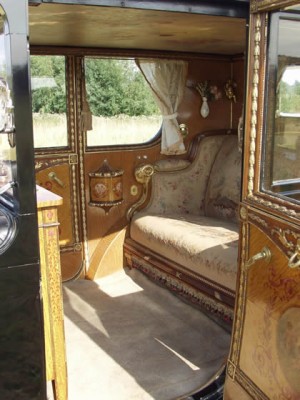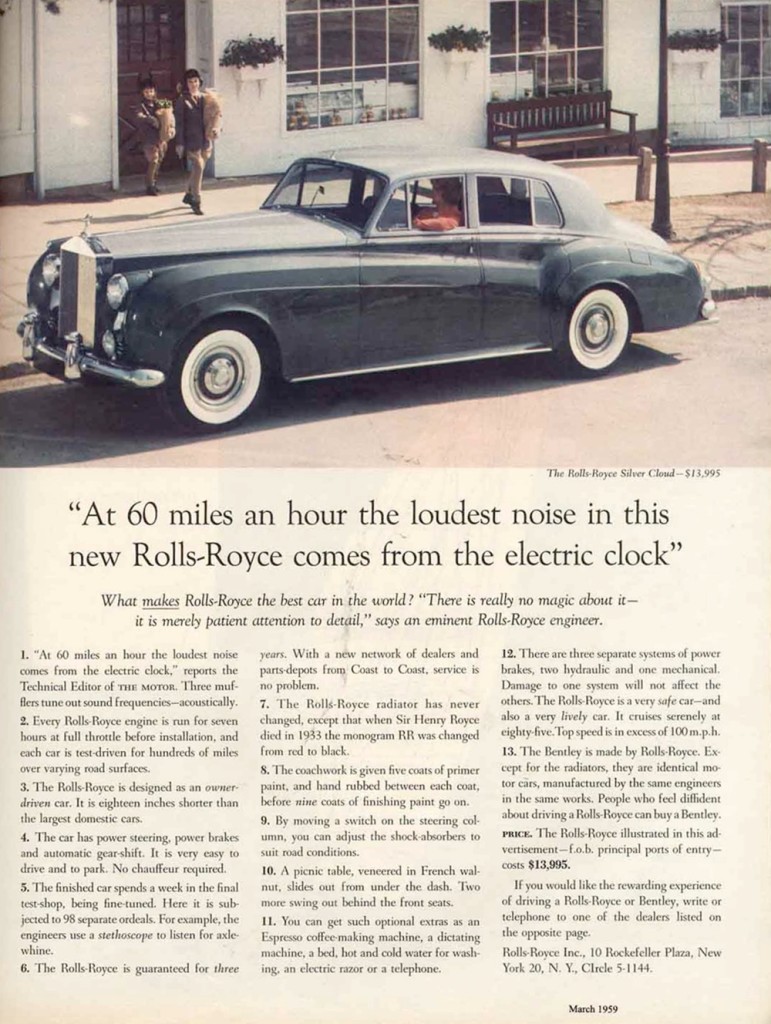The attitude of Rolls-Royce’s tradition-oriented clientele has butted heads the company’s determined efforts since the 1960′s to tone down the “chauffeurs and baronial halls” in the car’s collective image, yet the Rolls Royce has remained over the years and ecades primarily a car for heads of state, towering social grandees, and the upper-bracket very rich of the world.
In the late 1950′s, the advertising firm Ogilvy, Benson & Mather was commissioned to show Rolls-Royce in the context of American life- presumably being driven to cook-out and boy scout events by women in curlers- while the concept did indeed dramatically increase the sale of Rolls-Royce’s and Bentleys in the United States, it did absolutely nothing to diminish the ineffable spendour traditionally associated with the cars.

—Brougham de Ville by Charles Clark of Wolverhampton. Black and Cream with Black hide upholstery to front and tapestry cloth to rear. Low mileage and extensive history with only 4 owners from new. Considered as one of the most important Rolls-Royce Motor Cars ever. The rear interior is French styled with oil painting as the headlining. Formerly part of the famous Stanley Sears collection.—click image for source…
Long after the rest of the world’s car manufacturers assumed that all but a fraction of their products would be owner driven, Rolls-Royce both factually and by implication assumed that owners of its cars would have limitless resources of servants to drive and to maintain their automobiles. The management adopted a very high tone with tis patrons with complex handbooks of maintenance which pre-supposed Rolly Royce ownership by people for whom the servant problem did not exist, and the assumption was flattering to people who not only drove their own cars but emptied the ashtrays as well. Rolls-Royce found itself elevated far above the estate of a merely elegant and well-appointed agency of personal transport, into an article of faith and a way of life itself.

—Proof, if any was needed, that the headline is 90% of ad copy. If you can’t get that right, then you won’t draw in the audience, which makes the rest of your copy completely redundant.
“At 60 miles an hour the loudest noise in this new Rolls-Royce comes from the electric clock” is often cited as the greatest ad headline of all time; it shows fantastic understanding of an audience searching for a vehicle that provides ultimate luxury.
Today, the only impressive thing about this headline might be that alludes to a quiet car, but back in 1958, when this ad was published, an electric clock in a car was pretty swish, too; sewing those two points together seamlessly shows the brilliance of Ogilvy.
Even the subtlety of using the word “noise” is fantastic. You could use “sound” instead of “noise”—they both mean the same thing—but “noise” connotes a problem, an irritant… yet that minor ticking is anything but noise, really.
Read more: http://www.marketingprofs.com/articles/2013/10172/lessons-from-the-greatest-marketer-of-all-time-expelled-from-oxford#ixzz2TvDKs9HD—
It is in the great body of Rolls-Royce anecdote, lying in the misty realms between fact and fiction and partaking of both, that the greatest opportunity lies for some specially imaginative student of national mores. The one-time high interior construction of Rolls-Royce for heads of state and giants of finance was, of course, largely predicated on the wearing of high silk hates by their occupants, and was retained as a vestigial heritage from the past in an age when silk hats were less universal than they had been. ( to be continued)…
ADDENDUM:
(see link at end)…For decades, Iran’s reverence of the British motor car was expressed in mass output of imitation Hillman Hunters, rebranded as the Peykan, before obsolescence caused production to be halted.
Now, an Iranian motor manufacturer is going several streets upmarket to pay homage to another classic UK make: the Rolls-Royce.
Aryaman Motors, a Tehran-based company specialising in reproducing classic cars, is marketing replica vehicles based on the original design of the earliest Rolls- Royce models.
The cars are hand-built from scrat
o recreate the bodywork and hallmarks of models produced in Britain about 100 years ago.Inside, they are fitted with modern specifications such as air conditioning, orthopaedic seats and even CD players, fridges and televisions if customers request them. Hi-tech soundproofing reduces the noise of the 2.5l engine.
Aryaman Motors began producing the cars after receiving an order from Saad Abad Palace museum in north Tehran for a remake of the 1919 Silver Ghost model once owned by Reza Shah, the monarch who ruled Iran for two decades until the second world war.
The original was damaged after being confiscated by the Islamic martyrs foundation following the 1979 revolution that ousted his son, Mohammad Reza Pahlavi. The imitation car is now a museum exhibit; visitors can be driven around the grounds of the former royal palace for 60p a time before paying a visit to the complex’s Museum of Reminiscence and Warning, the Museum of Military Implements or the Natural History Museum.
Those wishing the pleasure of ownership will have to pay a higher price – £76,000. That figure has not deterred a small but wealthy number of enthusiasts in Iran and neighbouring Gulf states from requesting their own models, keeping Arayman’s order book full.Read More:http://www.guardian.co.uk/world/2009/sep/27/rolls-royce-classic-cars-iran





 COMMENTS
COMMENTS